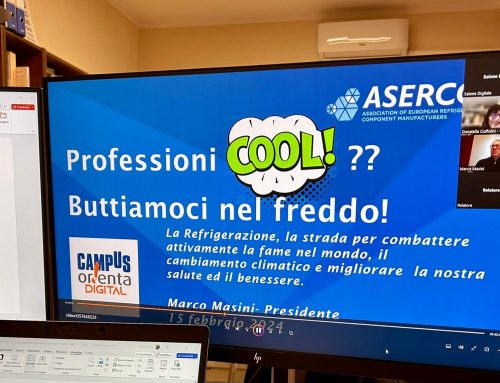More than 330 participants, two exclusive presentations about EU regulations, and three campfire sessions where speakers and participants got the chance to discuss – the first ASERCOM-EPEE eSymposium was packed with information and online discussions. The first speeches were delivered by Rados Horacek and Bente Tranholm-Schwarz of the European Commission. Horacek explained the principles and the timetable of the European Green Deal. Tranholm-Schwarz provided an overview of the F-gas regulation and its upcoming revision.
How is the EU political and regulatory landscape impacting the HVAC&R Industry?
The first discussion is based on the F-Gas Regulation being (not) ambitious enough and why it would be better to focus on energy efficiency instead of F-gases.
According to Rainer Grosse-Kracht, ASERCOM chairman, most of the component manufacturers have done their homework and are able to offer components that suite for what the regulation demands. Nevertheless, it is necessary to see the process as a whole. Handling those components is not that easy: installers and service companies need to adapt to these changes. Taking in account that most of the low-GWP refrigerants are flammable, extensive training and therefore time is needed. Under given circumstances the consensus of all participants is that the regulation is ambitious enough.
On the question whether a focus on energy efficiency would be more goal-oriented the participants state that it’s fairly clear industry has to do both. “It’s not like you can do one or the other: you can do both and even have synergies and get a better result in both cases”, Bente Tranholm-Schwarz from DG CLIMA states.
COVID-19 and EU Recovery Plan: Only a challenge or also an opportunity?
The second round revolves around the EU’s 1.8 trillion-euro rescue fund. How much of the total amount of money is going to arrive at the industry?
It seems the time to market for these trillions of euros is very long and it seems also that it depends a lot on what the member states see as necessity. If we want to have the money arriving at the industry, we will have to work on the member state level first (and not so much on the Brussels level). The allocation could be quick, but it won’t be funds that are immediately available to rescue people that are in need right now. Having the money at a national level by the end of 2021 would be a very good job.
Further, the question whether regulatory focus should be on new refrigerants was addressed. When it comes to regulatory focus on new refrigerants the experts think that both sectors – alternative technologies and F-gases – should be regulated in the same way. There should be the same provisions and regulations for alternative refrigerants, too. “What is called right now F-Gas Regulation should probably be called Refrigerants Regulation” is the statement Marco Buoni from AREA provides us with. Lastly Rana Adib from REN-21 hints that there is a need from the regulatory side to create the right frameworks in order to encourage change from within the industry.
Views from industry around the world: putting things back into the global context
The third campfire brings experts from all over the world together at one place. COVID-19’s impact on the whole global industry is the topic of the hour. Especially indoor air quality is being highlighted and enriched with insights from North America and Asia. The pandemic is not only a threat, but also an opportunity for moving in the right direction.
According to Martin Luymes from Martin HRAI (Canada) there is a recognition that indoor air quality must be addressed. The Canadian Government’s interest in this topic rose as the pandemic took over the world. Awareness has been generated and government-funded programs in retrofitting homes for increasing energy efficiency were announced. COVID-19’s impact allowed the “start of a discussion”. He is also very optimistic, that they are recently making some good progress.
On the other side of the globe the virus contributes to a significant ventilation industry growth. Hyukjoong Kwon from KRAIA (Korea) expects that they can “enlarge the size” of the industry after COVID-19. This trend results in a high motivation to develop new technologies related to the industry. “As a part of this, our association has been establishing research institutes” he proudly announces.






